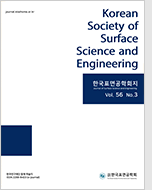
- Past Issues
- e-Submission
-

2021 Impact Factor 1.766
5-Year Impact Factor 1.674
Editorial Office
- +82-2-563-0935
- +82-2-558-2230
- submission@kssse.or.kr
- https://www.kssse.or.kr/

2021 Impact Factor 1.766
5-Year Impact Factor 1.674
The Korean Society of Surface Science and Engineering 2024;57(4):317-324. Published online: Sep, 9, 2024
DOI : 10.5695/JSSE.2024.57.4.317
We demonstrate a direct growth of carbon nanotubes (CNTs) on the surface of LiFePO4 (LFP) powders for use in lithium-ion batteries (LIB). LFP has been widely used as a cathode material due to its low cost and high stability. However, there is a still enough room for development to overcome its low energy density and electrical conductivity. In this study, we fabricated novel structured composites of LFP and CNTs (LFP-CNTs) and characterized the electrochemical properties of LIB. The composites were prepared by direct growth of CNTs on the surface of LFP using a rotary chemical vapor deposition. The growth temperature and rotation speed of the chamber were optimized at 600 °C and 5 rpm, respectively. For the LIB cell fabrication, a half-cell was fabricated using polytetrafluoroethylene (PTFE) and carbon black as binder and conductive additives, respectively. The electrochemical properties of LIBs using commercial carbon-coated LFP (LFP/C), LFP with CNTs grown for 10 (LFP/CNTs-10m) and 30 min(LFP/CNTs-30m) are comparatively investigated. For example, after the formation cycle, we obtained 149.3, 160.1, and 175.0 mAh/g for LFP/C, LFP/CNTs-10m, and LFP/CNTs-30m, respectively. In addition, the improved rate performance and 111.9 mAh/g capacity at 2C rate were achieved from the LFP/CNTs-30m sample compared to the LFP/CNTs-10m and LFP/C samples. We believe that the approach using direct growth of CNTs on LFP particles provides straightforward solution to improve the conductivity in the LFP-based electrode by constructing conduction pathways.
Keywords Lithium ion batteries, Direct growth, Carbon nanotubes, LiFePO4 powder, Rotary chemical vapor deposition